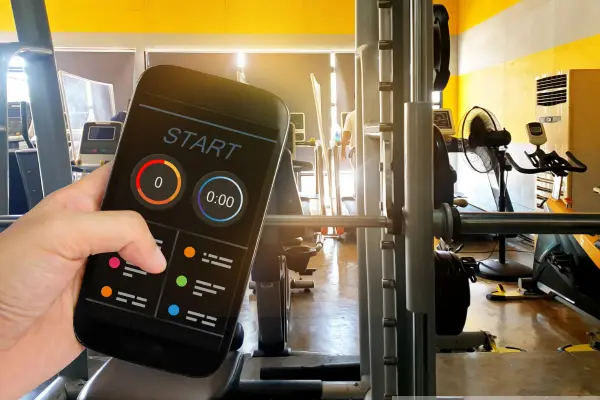Table of Contents
The Benefits of Bodyweight Exercises You Can Do Anywhere
Bodyweight exercises you can do anywhere are perfect for those who want to stay fit without needing a gym. These exercises use your own body weight as resistance, making them versatile and convenient. One of the key benefits of bodyweight exercises is their flexibility. You can do them at home, in a park, or even in a hotel room while traveling. No equipment is required, which means you can maintain your fitness routine regardless of your location or schedule.
- Versatility: Bodyweight exercises can be modified to suit any fitness level, whether you are a beginner or advanced.
- Cost-Effective: Since no equipment is needed, bodyweight exercises are free and accessible to everyone.
- Functional Fitness: These exercises mimic real-life movements, improving balance, coordination, and strength.
- Efficiency: You can target multiple muscle groups in a single workout, making it easy to maximize your time.
In addition to these benefits, bodyweight exercises help improve your overall fitness by enhancing strength, flexibility, and endurance. They are also excellent for cardiovascular health, especially when performed in a high-intensity circuit. Furthermore, because they can be done anywhere, bodyweight exercises remove the barriers that often prevent people from working out regularly. Therefore, incorporating these exercises into your routine can help you stay active, healthy, and fit, regardless of your circumstances. It’s easy to see why bodyweight exercises you can do anywhere are so popular among fitness enthusiasts.
Push-Ups: A Classic Upper Body Workout
Push-ups are one of the most effective bodyweight exercises you can do anywhere, targeting multiple upper body muscles. This exercise primarily works your chest, shoulders, and triceps but also engages your core and lower back. One of the best things about push-ups is their adaptability. You can modify them to increase or decrease the difficulty, making them suitable for all fitness levels.
- Standard Push-Up: Start in a plank position with your hands slightly wider than shoulder-width apart. Lower your body until your chest nearly touches the floor, then push back up. Keep your body in a straight line from head to heels.
- Knee Push-Up: If you’re a beginner, try the knee push-up. Perform the same motion as a standard push-up, but keep your knees on the ground for support.
- Incline Push-Up: To make it easier, place your hands on a raised surface like a bench or table. This reduces the amount of body weight you need to lift.
- Decline Push-Up: For more challenge, elevate your feet on a raised surface. This shifts more weight onto your upper body, increasing the intensity.
Push-ups are a highly effective bodyweight exercise that you can easily incorporate into your routine. They build upper body strength, improve muscle endurance, and enhance core stability. Because push-ups require no equipment, you can perform them in any space. Whether you’re at home, in the office, or outdoors, you can always fit in a few push-ups to maintain your strength and fitness. Consistently practicing push-ups can lead to significant improvements in your upper body power and overall muscle tone.
Squats: Strengthen Your Lower Body Anywhere
Squats are another fundamental bodyweight exercise you can do anywhere, targeting your lower body muscles. This exercise primarily focuses on your quadriceps, hamstrings, glutes, and calves. Squats also engage your core and improve your balance, making them an essential part of any workout routine. The best part about squats is their simplicity and effectiveness. You can perform them in a small space, and no equipment is required.
- Standard Squat: Stand with your feet shoulder-width apart. Lower your body as if you’re sitting back into a chair, keeping your chest up and your knees over your toes. Push through your heels to return to the starting position.
- Sumo Squat: For a variation, try the sumo squat. Stand with your feet wider than shoulder-width apart and your toes pointed slightly outward. Lower into the squat, then rise back up.
- Jump Squat: To add intensity, incorporate jump squats. Perform a standard squat, but as you rise, explode into a jump. Land softly and immediately go into the next squat.
- Pulse Squat: Hold a squat position and pulse up and down slightly to increase the time under tension, which intensifies the workout.
Squats are a versatile bodyweight exercise that helps build lower body strength and improve mobility. Regularly practicing squats can enhance your athletic performance, making everyday movements like climbing stairs or lifting objects easier. Additionally, squats can help boost your metabolism by engaging large muscle groups, contributing to fat loss. Because squats can be done anywhere, they are an excellent choice for maintaining lower body fitness when you don’t have access to a gym. Incorporating squats into your routine will lead to stronger legs, improved balance, and greater overall fitness.
Planks: Core Strengthening Anywhere You Go
Planks are one of the best bodyweight exercises you can do anywhere for strengthening your core muscles. This exercise targets your entire core, including your abdominals, obliques, and lower back. Planks also engage your shoulders, chest, and legs, making them a full-body workout. The simplicity of the plank makes it easy to perform anywhere, whether you’re at home, in a park, or even in a hotel room.
- Standard Plank: Begin in a push-up position, but rest on your forearms instead of your hands. Keep your body in a straight line from head to heels, engaging your core. Hold the position for as long as possible.
- Side Plank: To target your obliques, try the side plank. Lie on your side and lift your body off the ground, balancing on one forearm and the side of your foot. Hold this position, then switch sides.
- Plank with Leg Lift: Increase the difficulty by lifting one leg while holding the standard plank position. Alternate legs to engage your glutes and hamstrings.
- Plank to Push-Up: Start in a plank position, then transition to a push-up position by placing your hands on the ground. This dynamic movement works both your core and upper body.
Planks are an incredibly effective bodyweight exercise for building core strength and stability. A strong core is essential for overall fitness, as it supports your posture, balance, and movement efficiency. Because planks don’t require any equipment, you can easily incorporate them into your daily routine, no matter where you are. Regularly practicing planks can lead to a stronger core, better posture, and improved athletic performance. By including planks in your workout routine, you’ll be able to maintain a strong and stable core, which is vital for overall health and fitness.
Lunges: Enhancing Mobility and Strength Anywhere
Lunges are a powerful bodyweight exercise you can do anywhere to strengthen your legs, hips, and core. This exercise primarily targets your quadriceps, hamstrings, and glutes, while also improving balance and coordination. Lunges are incredibly versatile, offering numerous variations to keep your workout challenging and effective. Because they require no equipment, lunges can be performed in any space, making them perfect for home workouts or when you’re on the go.
- Forward Lunge: Start by standing tall with your feet together. Step forward with one leg and lower your body until both knees are bent at 90 degrees. Push off the front foot to return to the starting position, then switch legs.
- Reverse Lunge: Instead of stepping forward, step backward into the lunge position. This variation places more emphasis on your glutes and hamstrings.
- Walking Lunge: Perform a lunge, but instead of returning to the starting position, step forward into another lunge with the opposite leg. This dynamic movement increases the intensity and challenges your balance.
- Side Lunge: Step out to the side and lower your body into a lunge, keeping one leg straight while the other bends. This targets the inner thighs and enhances lateral mobility.
Lunges are a functional exercise that mimics real-life movements, making them highly beneficial for daily activities and sports performance. Regularly practicing lunges can improve your leg strength, enhance your range of motion, and help prevent injuries. Because lunges can be done anywhere and require no equipment, they are an excellent choice for maintaining lower body fitness. Incorporating lunges into your workout routine will lead to stronger legs, improved balance, and better overall mobility, contributing to a well-rounded fitness regimen.
Burpees: Full-Body Conditioning Anywhere
Burpees are a high-intensity bodyweight exercise you can do anywhere, providing a full-body workout that boosts cardiovascular fitness, strength, and endurance. This exercise combines a squat, plank, and jump into one continuous movement, making it an excellent choice for burning calories and improving overall fitness. Burpees are especially effective for those who want to maximize their workout in a short amount of time, as they engage multiple muscle groups and elevate your heart rate quickly.
- Basic Burpee: Start in a standing position. Drop into a squat, place your hands on the ground, and kick your feet back into a plank position. Perform a push-up, then jump your feet back to your hands and explode into a jump as you return to standing.
- Modified Burpee: For beginners, you can eliminate the push-up and jump, focusing on the squat and plank transitions to build strength and coordination.
- Burpee with Tuck Jump: To increase intensity, add a tuck jump at the end. After the push-up, jump your knees towards your chest before landing softly.
- One-Legged Burpee: For an advanced variation, try performing the burpee on one leg. This adds an extra challenge to your balance and core stability.
Burpees are an incredibly efficient exercise for improving cardiovascular health, burning fat, and building muscular endurance. Because they require no equipment and can be done in a small space, burpees are ideal for home workouts or when you’re short on time. Incorporating burpees into your routine will help you build full-body strength, increase your fitness level, and improve your stamina. Despite their intensity, burpees are a versatile exercise that can be adapted to suit different fitness levels, making them accessible to everyone. Whether you’re a beginner or an advanced athlete, burpees can help you achieve your fitness goals, no matter where you are.
Triceps Dips: Toning Your Arms Anywhere
Triceps dips are a simple yet effective bodyweight exercise you can do anywhere to target the muscles at the back of your arms. This exercise primarily focuses on the triceps but also engages your shoulders and chest. Triceps dips are particularly useful for those who want to tone and strengthen their upper arms without needing any equipment. Since you can perform triceps dips using a chair, bench, or even the edge of a sturdy table, they are incredibly convenient for at-home or on-the-go workouts.
- Basic Triceps Dip: Sit on the edge of a chair or bench with your hands gripping the edge, fingers facing forward. Slide your hips off the edge, keeping your knees bent, and lower your body until your elbows are bent at about 90 degrees. Push through your palms to raise your body back to the starting position.
- Straight-Leg Dip: For a more challenging variation, straighten your legs out in front of you. This increases the amount of body weight you lift, intensifying the exercise.
- Elevated Dip: Place your feet on a raised surface, such as another chair, to further increase the difficulty. This position engages your core and lower body muscles as well.
- Dip with Leg Raise: While performing a dip, lift one leg off the ground to add an extra balance challenge and engage your core.
Triceps dips are an excellent exercise for strengthening and toning your arms, improving both muscular endurance and definition. They are particularly beneficial for anyone looking to reduce arm flab and build upper body strength. Because triceps dips can be done with minimal equipment, they are perfect for home workouts or when you’re traveling. Incorporating triceps dips into your routine will help you achieve toned arms and a stronger upper body, enhancing your overall fitness. By practicing this exercise regularly, you can build strength and definition in your triceps, contributing to a balanced and well-rounded physique.
Mountain Climbers: Boosting Cardio and Core Strength Anywhere
Mountain climbers are an intense bodyweight exercise you can do anywhere, offering both cardiovascular and core strengthening benefits. This exercise involves a fast-paced, alternating knee drive that mimics the motion of climbing, making it an excellent choice for improving agility, speed, and endurance. Mountain climbers are highly effective for burning calories and enhancing overall fitness, as they engage multiple muscle groups simultaneously.
- Basic Mountain Climber: Start in a plank position with your hands directly under your shoulders. Quickly alternate driving your knees towards your chest, keeping your hips low and core engaged.
- Cross-Body Mountain Climber: To target your obliques, drive your knee towards the opposite elbow instead of straight ahead. This variation adds a rotational element to the exercise, engaging your core even more.
- Slow Mountain Climber: Perform the movement slowly and deliberately to focus on core strength and stability. This variation is great for beginners or for adding variety to your routine.
- Elevated Mountain Climber: Place your hands on a raised surface, such as a bench or step, to reduce the intensity. This is a good option for those who are just starting or want to focus on form.
Mountain climbers are a dynamic and efficient exercise that can be easily included in any workout routine. They help to improve cardiovascular endurance, strengthen your core, and enhance your agility. Because mountain climbers can be done anywhere and require no equipment, they are perfect for high-intensity interval training (HIIT) workouts or as part of a circuit. Regularly practicing mountain climbers will help you build a stronger core, increase your cardiovascular fitness, and improve your overall athletic performance. Whether you’re at home, in the park, or on the road, mountain climbers are a versatile and effective exercise that can take your fitness to the next level.
Glute Bridges: Strengthening Your Glutes and Core Anywhere
Glute bridges are a highly effective bodyweight exercise you can do anywhere to target your glutes, hamstrings, and core muscles. This exercise is particularly beneficial for improving hip stability, reducing lower back pain, and enhancing athletic performance. Glute bridges are simple to perform and require no equipment, making them an ideal addition to any home workout routine.
- Basic Glute Bridge: Lie on your back with your knees bent and feet flat on the ground, hip-width apart. Press through your heels to lift your hips off the ground until your body forms a straight line from shoulders to knees. Squeeze your glutes at the top, then lower back down.
- Single-Leg Glute Bridge: To increase the intensity, lift one leg off the ground while performing the bridge. This variation challenges your balance and engages your core even more.
- Glute Bridge with Pulse: At the top of the bridge, pulse your hips up and down slightly before lowering back down. This adds time under tension, intensifying the workout.
- Elevated Glute Bridge: Place your feet on a raised surface like a bench or step to increase the range of motion and the difficulty of the exercise.
Glute bridges are an excellent exercise for strengthening the glutes, improving core stability, and enhancing overall lower body strength. They are particularly useful for those who spend a lot of time sitting, as they help to activate and strengthen the glute muscles, which can become weak from prolonged sitting. Because glute bridges can be done anywhere, they are perfect for home workouts or when you need a quick lower body workout. Incorporating glute bridges into your routine will help you build stronger glutes, improve hip stability, and reduce the risk of lower back pain. This simple yet effective exercise is a must for anyone looking to enhance their lower body strength and overall fitness.
Bicycle Crunches: Engaging Your Core Anywhere
Bicycle crunches are an effective bodyweight exercise you can do anywhere to target your abdominal muscles, particularly the obliques. This exercise mimics the motion of pedaling a bicycle, making it a dynamic and engaging way to strengthen your core. Bicycle crunches are a great addition to any workout routine, especially for those looking to improve core strength and achieve a toned midsection.
- Basic Bicycle Crunch: Lie on your back with your hands behind your head and your knees bent. Lift your shoulders off the ground and bring one knee towards your chest while simultaneously twisting your torso to bring the opposite elbow towards the knee. Alternate sides in a pedaling motion.
- Slow Bicycle Crunch: Perform the movement slowly and with control to maximize muscle engagement and focus on form. This variation is great for beginners or those looking to increase the intensity of the workout.
- Elevated Bicycle Crunch: For an added challenge, keep your legs elevated off the ground throughout the exercise, without letting your feet touch the floor. This variation increases the engagement of the lower abdominals.
- Reverse Bicycle Crunch: Start in the same position but reverse the motion, extending one leg while bringing the opposite knee towards your chest. This variation emphasizes the lower abs and adds variety to your routine.
Bicycle crunches are an excellent exercise for targeting the entire core, especially the obliques. Regularly practicing bicycle crunches can help you build a stronger, more defined midsection, improving both your appearance and functional fitness. Because they require no equipment and can be done in a small space, bicycle crunches are perfect for home workouts or when you’re on the go. Incorporating bicycle crunches into your routine will help you achieve a stronger core, better balance, and improved overall fitness. This versatile exercise is a great way to challenge your abdominal muscles and enhance your workout routine, no matter where you are.
Jump Squats: Building Explosive Strength Anywhere
Jump squats are a powerful bodyweight exercise you can do anywhere, focusing on building explosive strength and improving lower body power. This exercise is a dynamic variation of the traditional squat that involves a jump at the top of the movement, adding an element of plyometrics that enhances both strength and cardiovascular fitness. Jump squats are highly effective for targeting the muscles in your legs, including the quads, hamstrings, glutes, and calves, making them an excellent choice for athletes and fitness enthusiasts alike.
- Basic Jump Squat: Start with your feet shoulder-width apart, lowering into a squat position by bending your knees and pushing your hips back. Once you reach the bottom of the squat, explode upwards into a jump, extending your legs fully and swinging your arms to gain momentum. Land softly with your knees slightly bent and immediately descend into the next squat.
- Narrow Stance Jump Squat: For a variation that targets the inner thighs and challenges your balance, perform the jump squat with your feet closer together. This variation requires greater stability and engages different muscle groups.
- 180-Degree Jump Squat: To add a twist and challenge your coordination, perform a 180-degree turn in the air during the jump. This variation helps to improve agility and spatial awareness.
- Weighted Jump Squat: For advanced athletes looking to increase the intensity, hold a pair of light dumbbells or wear a weighted vest while performing the jump squat. This adds resistance and further enhances lower body strength.
Jump squats are an excellent exercise for building explosive power, improving your vertical jump, and enhancing overall athletic performance. They also provide a cardiovascular challenge, making them a great addition to high-intensity interval training (HIIT) workouts. Because jump squats require no equipment and can be performed in a small space, they are perfect for home workouts, outdoor training, or as a quick fitness boost during the day. Regularly incorporating jump squats into your routine will help you build stronger, more powerful legs, increase your fitness level, and improve your athletic capabilities. This dynamic and versatile exercise is ideal for anyone looking to take their lower body strength and conditioning to the next level, no matter where they are.










